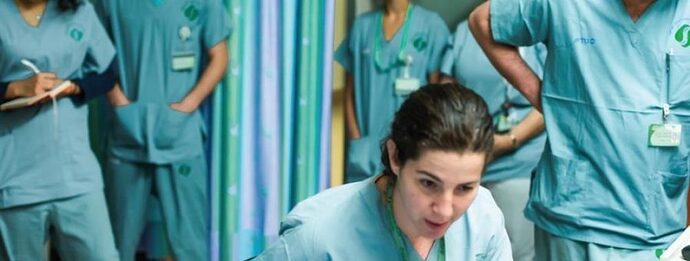There are creative ways to educate future doctors to think and not memorize, according to a recent Jerusalem symposium.
The place where he place where doctors perform surgery is called an operating theater because operations were originally carried out in tiered theaters or amphitheaters while male medical students and other spectators wearing black suits observed. The procedures were very unsterile and anesthesia was not used. Today’s operating rooms are spanking clean, brilliantly lit, modern, full of hi-tech gadgets – and they boast many women doctors, nurses and technicians.
One can learn many things in medicine from observing doctors and patients in surgical theaters, from watching movies and visiting medical museums and medical libraries. Medical libraries around the world use new digitized and printed volumes as well as also rare old anatomy and other books. Some also have medical museums with collections. Medical students tend to eye the future to be abreast of the most advanced technologies and techniques, but they also need to look backward to appreciate the time when general anesthesia and antibiotics, for example, were discovered. These basic yet revolutionary advances should not be taken for granted.
“In school, most pupils hate history because they had to memorize dates,” noted Prof. Yoel Donchin, a 73-year-old retired Hadassah University Medical Center anesthesiologist who now teaches the history of medicine at the Hebrew University Medical Faculty in the same Ein Kerem campus.
“Today, we can use visuals to explain medical history and practices.”
He was speaking last week at a small symposium titled “Do Anatomical Collections Still Matter?” held in honor of the visit to the medical school by colleagues from Riga’s Stradins University in Latvia, regarded as the world’s third-leading medical museum (after those in London and Washington).
The campus’s Berman Medical Library, directed by Sharon Lenga, with 60,000 book titles and 5,000 newspapers, has been modernized and refurbished and offers plenty of room for students to sit on lounge chairs and even on the carpeted floor. The museum, open to the public, is on the third floor of the library.
“We try to create an emotional experience for our visitors. We redesigned museum after thinking of ways to reengage visitors,” said Lenga. It is open five days a week (8:30 a.m. to 19:45 p.m. Sunday through Thursday) to students, faculty and the general public. The permanent exhibit complements the existing medical library, which serves the staff and 3,000 students of medicine, dentistry, pharmacy, nursing, public health and occupational therapy, in addition to clinical academic staff at the Hadassah University Medical Center. It is increasingly being digitized.
In the library, said Lenga, students take a breather and watch episodes of House M.D., the US TV medical drama that ran for eight seasons on the Fox network until 2012 and starred Hugh Laurie as Dr. Gregory House. Although the hero seemed to hate humanity and his diagnoses were unconventional, medical students have found discussing the fictional cases useful to their studies, Lenga said.
“For some time, we noticed that medical students didn’t stop by the library and museum,” said Lenga. “Now they do, and they want to know more. Like public libraries, we have changed our spaces to make them comfortable and welcoming for relaxation.”
TO GIVE some perspective to medical students in their 20s who take for granted that antibiotics “always existed,” Donchin gives a five-week course on presenting medical issues through movies. You can read the full study and article here.
